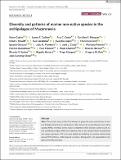Files in this item
Diversity and patterns of marine non-native species in the archipelagos of Macaronesia
Item metadata
| dc.contributor.author | Castro, Nuno | |
| dc.contributor.author | Carlton, James T. | |
| dc.contributor.author | Costa, Ana C. | |
| dc.contributor.author | Marques, Carolina S. | |
| dc.contributor.author | Hewitt, Chad L. | |
| dc.contributor.author | Cacabelos, Eva | |
| dc.contributor.author | Lopes, Evandro | |
| dc.contributor.author | Gizzi, Francesca | |
| dc.contributor.author | Gestoso, Ignacio | |
| dc.contributor.author | Monteiro, João G. | |
| dc.contributor.author | Costa, José L. | |
| dc.contributor.author | Parente, Manuela | |
| dc.contributor.author | Ramalhosa, Patrício | |
| dc.contributor.author | Fofonoff, Paul | |
| dc.contributor.author | Chainho, Paula | |
| dc.contributor.author | Haroun, Ricardo | |
| dc.contributor.author | Santos, Ricardo S. | |
| dc.contributor.author | Herrera, Rogelio | |
| dc.contributor.author | Marques, Tiago | |
| dc.contributor.author | Ruiz, Gregory M. | |
| dc.contributor.author | Canning-Clode, João | |
| dc.date.accessioned | 2022-02-02T10:30:19Z | |
| dc.date.available | 2022-02-02T10:30:19Z | |
| dc.date.issued | 2022-02-01 | |
| dc.identifier | 277706908 | |
| dc.identifier | 07fe5498-814a-4853-a14e-8132e68d83a4 | |
| dc.identifier | 000749343500001 | |
| dc.identifier | 85123953309 | |
| dc.identifier.citation | Castro , N , Carlton , J T , Costa , A C , Marques , C S , Hewitt , C L , Cacabelos , E , Lopes , E , Gizzi , F , Gestoso , I , Monteiro , J G , Costa , J L , Parente , M , Ramalhosa , P , Fofonoff , P , Chainho , P , Haroun , R , Santos , R S , Herrera , R , Marques , T , Ruiz , G M & Canning-Clode , J 2022 , ' Diversity and patterns of marine non-native species in the archipelagos of Macaronesia ' , Diversity and Distributions , vol. Early View . https://doi.org/10.1111/ddi.13465 | en |
| dc.identifier.issn | 1366-9516 | |
| dc.identifier.other | RIS: urn:A4C1CCFAEEE2B864A7281D0DB081F48C | |
| dc.identifier.other | ORCID: /0000-0002-2581-1972/work/107717997 | |
| dc.identifier.uri | https://hdl.handle.net/10023/24788 | |
| dc.description | Tiago Marques and Carolina Marques thank partial support by CEAUL (funded by FCT through the project UIDB/00006/2020). | en |
| dc.description.abstract | Aims The present study is the first attempt to grasp the scale and richness of marine biological invasions in Macaronesia. We pioneered a comprehensive non-native species (NNS), inventory in the region to determine their diversity patterns and native distribution origins. NNS were defined here as the result of both introductions and range expansions. We also used statistical modelling to examine relationships among NNS richness, anthropogenic activities, demographic and geographical variables across Macaronesia. Location Macaronesia. Methods A comprehensive literature search was conducted for marine NNS records in Macaronesia, registering the first record's location and year from 1884 to 2020. We used univariate and multivariate analyses to evaluate differences and similarities in community composition. By applying a Generalized Linear Model (GLM), we tested hypotheses regarding NNS richness as a function of anthropogenic activities, demographic and geographical variables. Results A total of 144 marine non-native species (NNS) were recorded for the whole of Macaronesia. The highest NNS richness was registered in the Canary Islands (76 NNS), followed by the Azores (66 NNS), Madeira (59 NNS) and finally Cabo Verde (18 NNS). Some differences amongst archipelagos were observed, such as the high number of non-native macroalgae in the Azores, fishes in the Canary Islands and tunicates in Cabo Verde. Overall, macroalgae, tunicates and bryozoans were the predominant taxonomic groups in the Macaronesian archipelagos. Madeira and Canary Islands were the archipelagos with more similarity in marine NNS, and Cabo Verde the most divergent. Finally, GLM suggested that non-native richness patterns across Macaronesia were dependent on the considered archipelago and strongly affected by (1) minimum distance to the mainland, (2) the total number of ports and marinas and (3) total marinas area (km2). Conclusions The model results and NNS listing in the present study will likely raise the awareness and response regarding marine NNS in the whole Macaronesia region, serving as a baseline for future research as well as implementing and enforcing regulations related to the introduction of marine NNS in oceanic islands. | |
| dc.format.extent | 18 | |
| dc.format.extent | 1349072 | |
| dc.language.iso | eng | |
| dc.relation.ispartof | Diversity and Distributions | en |
| dc.subject | Anthropogenic stressors | en |
| dc.subject | Azores | en |
| dc.subject | Cabo Verde | en |
| dc.subject | Canary Islands | en |
| dc.subject | Madeira | en |
| dc.subject | Meta-analysis | en |
| dc.subject | Modelling | en |
| dc.subject | Non-indigenous species | en |
| dc.subject | GC Oceanography | en |
| dc.subject | QH301 Biology | en |
| dc.subject | DAS | en |
| dc.subject | SDG 14 - Life Below Water | en |
| dc.subject.lcc | GC | en |
| dc.subject.lcc | QH301 | en |
| dc.title | Diversity and patterns of marine non-native species in the archipelagos of Macaronesia | en |
| dc.type | Journal article | en |
| dc.contributor.institution | University of St Andrews. School of Mathematics and Statistics | en |
| dc.contributor.institution | University of St Andrews. Scottish Oceans Institute | en |
| dc.contributor.institution | University of St Andrews. Centre for Research into Ecological & Environmental Modelling | en |
| dc.identifier.doi | 10.1111/ddi.13465 | |
| dc.description.status | Peer reviewed | en |
This item appears in the following Collection(s)
Items in the St Andrews Research Repository are protected by copyright, with all rights reserved, unless otherwise indicated.

